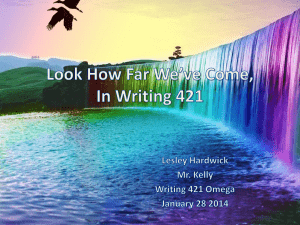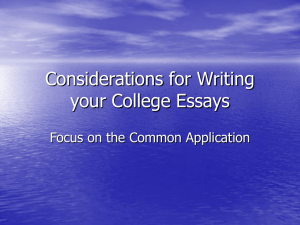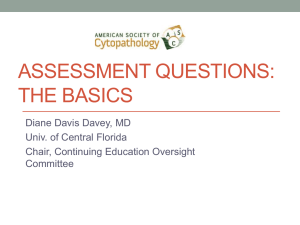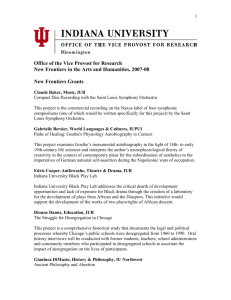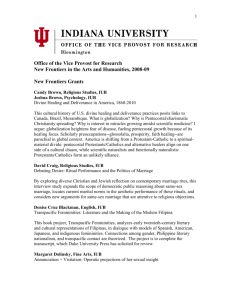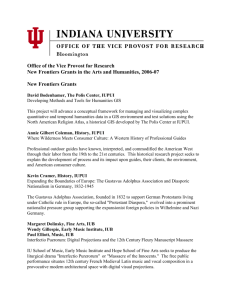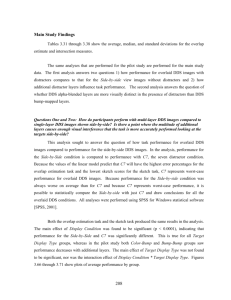PPTX
advertisement
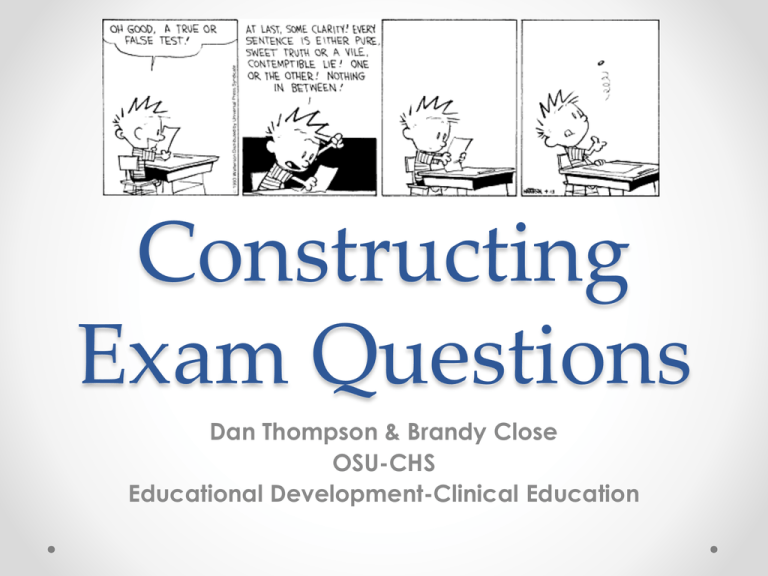
Constructing Exam Questions Dan Thompson & Brandy Close OSU-CHS Educational Development-Clinical Education Objectives • Use Bloom’s Taxonomy to identify the knowledge level of assessment items • Compose an effective and meaningful stem for Multiple Choice items • Construct effective and plausible distractors for Multiple Choice items • Construct effective assessment questions in the form of: Multiple Choice, True/False/ and Essay/Short Answer Planning the Assessment • Using Bloom’s taxonomy to categorize content/concepts by knowledge level. • Create a table to breakdown and organize assessment items by outcome level • Example: http://www.iub.edu/~best/pdf_docs/better_tests.pdf • Validity- does the assessment measure the learning outcomes you intend to measure with your assessment items? • Coordinating assessment content with instruction content increases the validity of the assessmenthttp://www.iub.edu/~best/pdf_docs/better_tests.pdf Constructing the Stem • The stem should be meaningful and present a problem • Focus on a learning outcome • Lack of a definite problem in the stem often assesses student’s inference as opposed to a direct measurement of performance http://cft.vanderbilt.edu/guides-sub-pages/writing-good-multiple-choice-test-questions/ http://cft.vanderbilt.edu/guides-sub-pages/writing-good-multiple-choice-test-questions/ • Try to avoid including irrelevant material in the stem o Can decrease the reliability and validity of the assessment item http://cft.vanderbilt.edu/guides-sub-pages/writing-good-multiple-choice-test-questions/ http://cft.vanderbilt.edu/guides-sub-pages/writing-good-multiple-choice-test-questions/ • Consider making the stem a question or partial sentence o A question stem allows students to focus on answering the assessment item, increasing validity o Avoid using inserted blanks as it increases cognitive load- can decrease validity of assessment item Constructing the Distractors • All distractors should be plausible o Serve to effectively indicate what students know o Incorrect distractors should be chosen by students who did not achieve the learning outcome o Incorrect distractors should be ignored by the students who did http://cft.vanderbilt.edu/guides-sub-pages/writing-good-multiple-choice-test-questions/ • Distractors should be clear and concise o Excessive wordiness assesses reading/comprehension as opposed to the actual desired outcome http://cft.vanderbilt.edu/guides-sub-pages/writing-good-multiple-choice-test-questions/ • Avoid using “all of the above” or “none of the above” o Students who can identify more than one correct distractor can choose correct answer without achieving the learning outcome o Conversely, students who can identify on incorrect distractor can choose correct answer without achieving the learning outcome • Distractors can contain inadvertent clues in the language, length, format, and grammar o o o o Keep grammar consistent with the stem Keep length similar Keep format similar Keep language similar http://cft.vanderbilt.edu/guides-sub-pages/writing-good-multiple-choice-test-questions/ Constructing True/False, Essay/Short Answer Items • True/False Items o Typically used at the knowledge level of assessment to measure recall of factual knowledge o Potential to measure higher level knowledge • Strengths of True/False Items o Easy to write and answered quickly by students o Provide a large sampling of content vs time allotted • Weaknesses of True/False Items o Problem with guessing- 50/50 chance of guessing correctly without achieving learning outcome o Ambiguity due to writing statements that are indisputably true or false http://www.iub.edu/~best/pdf_docs/better_tests.pdf • Guidelines to Constructing True/False questions: Assess significant material Write questions that are indisputably true or false Avoid taking statements directly from textbooks Assess only one point in each item Avoid trick questions Avoid terms such as : always, all, never…instead use: usually, often, many times o Avoid negatively worded statements o Randomize the order to avoid giving clues o Keep true and false statements/questions similarly formatted o o o o o o http://www.iub.edu/~best/pdf_docs/better_tests.pdf • Essay/Short Answer Items o Consider class-size o Consider time available to prepare the assessment • Strengths of Essay/Short Answer Items o o o o o Effective way to measure higher level thinking Require less time to construct Discourages students from memorizing and regurgitating facts Can provide students with realistic tasks/scenarios Requires student s to organize, construct, and communicate their thoughts • Weaknesses of True/False Items o Provide a smaller sampling of content due to time needed to answer each question o Require more time for grading: reading and scoring o Scoring is often more subjective than objective which can decrease reliability http://www.iub.edu/~best/pdf_docs/better_tests.pdf • Guidelines to Constructing Essay/Short Answer questions: o Create clearly defined questions…lead the student towards the approach you desire o To cover more content, consider more questions requiring shorter answers o Avoid giving optional essay questions- students choosing different essay questions to answer are essentially taking different exams o Indicate how much each essay/short answer question is worth o Avoid questions that only require providing factual information http://www.iub.edu/~best/pdf_docs/better_tests.pdf • Consider that higher level processes build upon lower level processes o If the lower level processes are not achieved, then the higher level one will be deficient • Examples of essay/short answer items by level of Bloom’s Taxonomy http://www.iub.edu/~best/pdf_docs/better_tests.pdf Questions?




